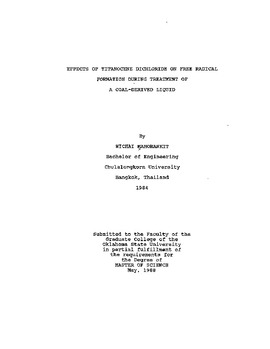| dc.contributor.advisor | Seapan, Mayis | |
| dc.contributor.author | Mahorankit, Wichai | |
| dc.date.accessioned | 2015-08-19T16:06:18Z | |
| dc.date.available | 2015-08-19T16:06:18Z | |
| dc.date.issued | 1988-05-01 | |
| dc.identifier.uri | https://hdl.handle.net/11244/15659 | |
| dc.description.abstract | Catalyst deactivation is a major problem in catalytic hydrotreatment of coal-derived liquids. Adding certain additives to feedstocks is one potential technique to retard catalyst deactivation and improve catalyst activity. Titanocene dichloride exhibited this characteristic to reduce coke formation and promote catalyst activities in hydrotreatment of a coal-derived liquid. The role of titanocene dichloride on the improvement was suspected to be due to the free radicals generated by the decomposition of titanocene dichloride. The experiments with treating the undoctored and doctored feedstocks under various conditions were conducted in a trickle-bed reactor system. The effects of titanocene dichloride on the free radical formation during the process were studied by using Electron Spin Resonance spectroscopy. The effects of titanocene dichloride on catalyst activity were evaluated by determinations of elemental composition and boiling range ditribution of the treated oil. The effects of titanocene dichloride on catalyst deactivation were also studied by characterization of the aged catalyst. The presence of titanocene dichloride in the feedstock increased the formation of free radicals in the entire temperature range of 250 c to 400 c, with rates of recombination and hydrogen capping reactions strongly affecting the concentration of free radicals in the products. The catalyst showed a significant effect on free radicals, catalyzing their reaction with hydrogen and reducing their concentration. Free radicals appear to be formed by two different mechanisms in the lower (about 250 C) and higher (about 375 C) temperature ranges. Titanocene dichloride appeared to slightly promote HDN at temperatures higher than 350 c. Although no coke suppression was observed with the presence of titanocene dichloride, the loss of catalyst pore volume and surface area was reduced with the doctored feeds. Several profiles of the titanium deposit within the spent catalysts were observed along the reactor under nitrogen atmosphere, whereas the titanium deposit within the catalysts from the hydrotreating runs had a shell-maximum profile. Coke formation on the spent catalysts under hydrogen and nitrogen atmospheres is caused by different coking mechanisms. Two distinctly different coking profiles along the reactor were observed under hydrogen and nitrogen atmospheres. | |
| dc.format | application/pdf | |
| dc.language | en_US | |
| dc.publisher | Oklahoma State University | |
| dc.rights | Copyright is held by the author who has granted the Oklahoma State University Library the non-exclusive right to share this material in its institutional repository. Contact Digital Library Services at lib-dls@okstate.edu or 405-744-9161 for the permission policy on the use, reproduction or distribution of this material. | |
| dc.title | Effects of Titanocene Dichloride on Free Radical Formation During Treatment of a Coal-derived Liquid | |
| dc.type | text | |
| dc.contributor.committeeMember | Johnson, Marvin M. | |
| dc.contributor.committeeMember | Robinson, Robert S., Jr. | |
| osu.filename | Thesis-1988-M216e.pdf | |
| osu.accesstype | Open Access | |
| dc.description.department | Chemical Engineering | |
| dc.type.genre | Thesis | |
